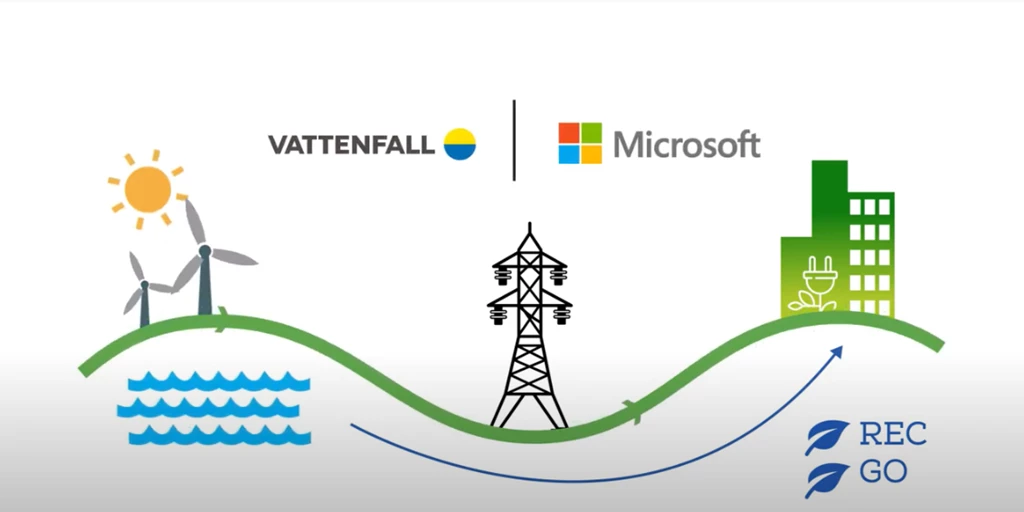Azure IoT Central, Internet of Things, Thought leadership
Achieving 100 percent renewable energy with 24/7 monitoring in Microsoft Sweden
Posted on
3 min read
Earlier this year, we made a commitment to shift to 100 percent renewable energy supply in our buildings and datacenters by 2025. On this journey, we recognize that how we track our progress is just as important as how we get there.
Today, we are announcing that Microsoft will be the first hyperscale cloud provider to track hourly energy consumption and renewable energy matching in a commercial product using the Vattenfall 24/7 Matching solution for our new datacenter regions in Sweden, which will be available in 2021.
Vattenfall and Microsoft are also announcing that the 24/7 hourly matching solution—the first commercial product of its kind—is now generally available. Vattenfall is a leading European energy company with a strong commitment to make fossil-free living possible within one generation. The solution is built using Microsoft’s Azure services, including Azure IoT Central and Microsoft Power BI.
Today’s announcement builds on last year’s partnership announcement with Vattenfall when the 24/7 Matching solution was first introduced. Since then, the solution has been in pilot in Vattenfall headquarters in Solna and the new Microsoft headquarters in Stockholm, which has seen 94 percent of the total office building energy consumption matched with Swedish wind and 6 percent matched with Swedish hydro power.
We continually invest in new ways to make our buildings and datacenters more energy efficient and sustainable. As part of today’s announcement, Microsoft is signing a power purchase agreement (PPA) to cover 100 percent of Microsoft’s energy consumption in Sweden. Microsoft will ensure that the company’s operations in Sweden use renewable energy.
The Vattenfall 24/7 Matching solution enables us to have a more accurate picture of energy used to match with Guarantees of Origin (GOs). This marks another important step in our commitment to be carbon negative by 2030 and use 100 percent renewable energy by 2025.

Vattenfall and Microsoft 24/7 matching of renewable energy. Source: Vattenfall and Microsoft pilot world’s first hourly matching (24/7) of renewable energy.
Increasing transparency and accuracy of renewable energy matching
Fulfilling our 100 percent renewable energy commitment requires a better way of tracking renewable electricity. Today, the industry is using Energy Attribute Certificates, called Guarantees of Origin (GOs) in Europe and Renewable Energy Certificates (RECs) in the US. These ensure that the amount of electricity sold corresponds to the amount produced. GOs allow end consumers to choose electricity from a specific source; this enables them to choose electricity exclusively from renewable sources such as wind, solar, or hydropower.
While we have seen remarkable progress toward renewable sourcing and commitments, there is a fundamental flaw in monitoring the source and quantity of energy consumed. For any given hour, a business does not know the source of the energy they are consuming. That energy may come from renewable sources, or it may be produced from fossil fuel. The current system has no way of matching the supply of renewable energy with demand for that energy on an hourly basis. And without the transparency of supply and demand, market forces cannot work to ensure that renewable energy demand is supplied from renewable sources.
Through this solution, Microsoft Sweden’s new home is powered by renewable energy through the procurement of GOs, which traces electricity from renewable sources to provide information to electricity customers on the source of their energy—not just on a monthly or yearly basis, but on an hourly basis.
The 24/7 matching of GOs and renewable energy credits (RECs) offers the following benefits:
- Businesses can see if their commitment to 100 percent renewable energy cover each hour of consumption and translate sourcing of renewable energy into climate impact.
- Energy providers can more easily understand demands for renewable energy hour-by-hour and take action to help production meet demand.
- 24/7 matching of consumption to production drives true market demand for renewable energy. As 24/7 hourly renewable products are rolled out across the world, they will incentivize investment in energy storage such that energy companies can store renewable energy when it is generating, so they can continue to supply their customers with renewable energy when it is not. Over time, this storage will allow electricity grids to supply 100 percent decarbonized power.
- The system can inspire regulatory change in how GOs and RECs are created, acquired and retired.
You can learn more about the advantages of 24/7 monitoring by watching the Vattenfall 24/7 solution video.
IoT for more accurate energy monitoring
IoT enables companies to gain near real-time insights of the physical world, connecting objects to give you insights into the health of a system or process, predict failures before they happen and gain overall efficiencies in operations.
The Vattenfall 24/7 hourly monitoring solution leverages Azure IoT Central to manage the full picture of energy consumption in a given building. Azure IoT Central helps solution builders move beyond proof of concept to building business-critical applications they can brand and sell directly or through Microsoft AppSource. Today, Microsoft offers two IoT Central energy app templates for solar panel and smart meter monitoring to help energy solution builders accelerate development.
Commitment to building world-class, sustainable datacenters
We believe that our datacenters should be positive contributors to the grid, and we continue to innovate in energy technology and monitoring resources to support our corporate commitment to be carbon negative by 2030.